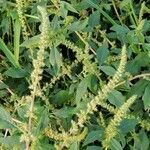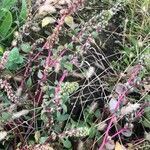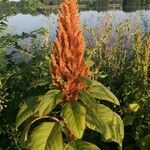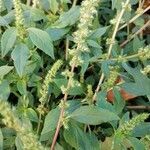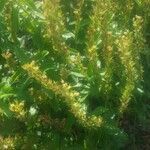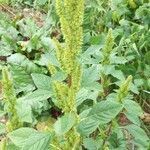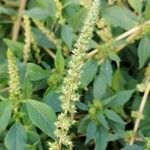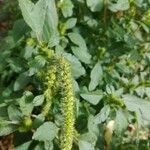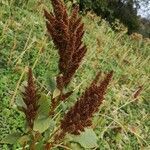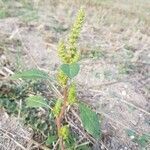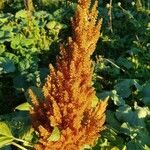Plants glabrous or glabrescent, or distal parts of stem and branches slightly pubescent when young. Stems erect, green or sometimes reddish purple, rarely under-developed plants ascending, branched to nearly simple, 0.3-2(-2.5) m. Leaves: petiole 1/2 as long as to equaling blade; blade ovate, rhombic-ovate, or lanceolate, (2-)4-15 × (1-)2-6 cm, base cuneate to broadly cuneate, margins entire, apex acute to obtuse, with mucro. Inflorescences terminal and axillary, erect or reflexed, occasionally nodding, green or olive green, occasionally with silvery or reddish purple tint, leafless at least distally, terrminal inflorescence often slightly nodding with numerous shorter branches at base. Bracts lanceolate-linear to subulate, 2-3.5(-4) mm, subequal to or 2 times as long as tepals }, apex spinescent. Pistillate flowers: tepals 5, lanceolate to lanceolate-linear, subequal or unequal, 1.5-3 mm, membranaceous, apex acute or acuminate, gradually narrowing into aristate tip; style branches erect, shorter than body of fruit; stigmas 3. Staminate flowers at tips of inflorescences; tepals 5; stamens (4-)5. Utricles obovoid or elongate-ovoid, 1.5-2.5 mm, shorter than tepals, smooth proximally, lid verrucose or rugose, dehiscence regularly circumscissile, or rarely in some presumably hybrid forms, irregularly dehiscent or indehiscent. Seeds black to dark reddish brown, lenticular to lenticular-globose, 1-1.3 mm, smooth, shiny.
Annual, monoecious (or sometimes flowers bisexual), robust herb to 2.5 m, often smaller; stems green to red; indument of stems, young leaves and inflorescence axes more or less densely pubescent with tangled white hairs or sometimes glabrous. Petiole to 3(-12) cm long; blade subelliptical, ovate, rhombic-ovate or lance-ovate, 2-10(-15) x 1-7(-10) cm, obtuse or acute, slightly notched at apex, entire or minutely crenulate. Inflorescence of large axillary and terminal spikes or panicles 1-20 cm long; bracts lanceolate or ovate, usually 3.5 mm or longer (-4.5 mm), elongated with green midvein extending into a subulate, spinulose apex, conspicuously exceeding tepals so that whole inflorescence often appears bristly. Flowers green, white or reddish. Male flowers occurring in most parts of inflorescence; tepals 5, unequal, narrowly oblong or ovate, 1.3-3.0 mm long, acute; stamens 5. Female flowers, tepals 5, unequal, oblong, longest (outer) 1.3-2.5 mm long, acute, spreading at maturity, shorter than utricle; styles (2)3. Utricle circumscissile, subglobose, 2.0-2.5 mm long, slightly to conspicuously rugulose; seed lenticular or cochleate-orbicular, 0.8-1.1 x 0.9-1.3 mm, dark reddish-brown or black, lustrous.
Annual to c. 1 m high, erect, branched, often red-tinged, with stout ribbed hairy stems, sometimes slender if in impoverished dry soil. Petioles of lower lvs to 10 cm long, hairy or glabrous. Lamina 6-15 × 2-7.5 cm (smaller lvs subtending infl.), ovate, lanceolate-ovate to elliptic-ovate, becoming glabrous apart from puberulent nerves below; base cuneate; apex obtuse or acute. Panicle crimson-red or green, much-branched; main axis erect, to c. 20 cm high; branches spreading, further divided or not. Spikes densely arranged, c. 5 mm wide, short or slender and up to 5-(10) cm long. Bracteoles 2-4 mm long, ovate with subulate tip; keel greenish or red. Perianth 5-merous. Tepals 5, unequal, mostly 1-2 mm long (the longest c. 3 mm long), elliptic-oblong, acute or shortly acuminate, green or reddish with darker keel; tepals of ♂ fls slightly > ♀ at anthesis. Stigmas 3-(4), usually > tepals. Fr. = or > perianth, circumscissile, obovoid, with very short neck. Seed 1-1.2-(5) mm diam., ± orbicular, shining dark brown or black; margin keeled.
Rather coarse often pubescent annuals to 2.5 m. high with ascending branches. Leaves pubescent or glabrous, entire to minutely crenulate, deltoid-to rhombic-ovate, apically rounded to acute, often mucronate, basally acute to rounded, 2-15 cm. long, 1-7 cm. broad; petioles 1-8 cm. long. Inflorescences of congested thyrses racemosely disposed, the terminal and axillary thyrses mostly cylindric, 6-12 mm. broad. Flowers polygamo-monoecious or monoecious; bracts and bracteoles subequal, lanceolate to ovate, 2-4 mm. long, often conspicuously longer than the flowers; sepals lanceolate to ovate or obovate, acute to acuminate, 1.5-2.5 mm. long, the midribs dark green, the margins scariose, rarely tinged with anthocyanins; stamens 5, discrete, 1-3 mm. long; ovary ovoid; styles (2-) 3, conical; stigmata (2-) 3, fimbrillate. Fruit a slightly rugose compressed ovoid utricle, circum-scissile near the middle, 2-2.5 mm. long; seeds cochleate-orbiculate, reddish brown to black, minutely reticulate, 1-1.3 mm. broad.
Monoecious, to 2 m, usually freely branched, scurfy-villous at least in the infl; lvs long-petioled, ovate or rhombic-ovate or lanceolate, mostly acutish, the larger ones on well developed plants often 15 cm or more; infl dull greenish or slightly reddish, not showy, terminal, lax, generally with many short, crowded lateral branches and often with nodding tip; bracts mostly 3–4 mm, slightly surpassing the sep and fr, with fairly thick, long-excurrent midrib; sep 5, those of the pistillate fls mostly 1.5–2 mm, about equaling the fr, with simple midvein, straight, acute; stamens 5; style-branches rather short, erect; fr rugose, circumscissile; seed dark brown, ca 1 mm; 2n=32. Originally native to tropical Amer., now a cosmopolitan weed.
Stem 30-50 cm tall, branched, pubescent. Petiole 1-2.5 cm, hairy; leaf blade ovate or ovate-rhombic, 3-4.5 × 1.5-2.5 cm, abaxially pilose, adaxially nearly glabrous, base cuneate, margin undulate, apex acute or notched, with a mucro. Complex thyrsoid structures terminal, slender, somewhat drooping at apex and in spikes. Bracts and bracteoles subulate, lanceolate, 3.5-4 mm, distinctly long pointed, longer than perianth. Tepals oblong-lanceolate, ca. 2 mm, apex acute, with a mucro. Stamens nearly as long as or slightly longer than perianth; stigmas 3. Utricles ovoid, longer than perianth, ca. 2 mm, circumscissile. Seeds black, subglobose, ca. 1 mm in diam. Fl. Jul-Aug, fr. Sep-Oct. 2n = 24, 32*, 33, 34.
Flowers in yellowish, green, reddish or purple axillary and terminal spikes formed of cymose clusters which are increasingly closely approximate upwards, the terminal inflorescence varying from a single spike to a broad, much-branched panicle up to c.45 × 25 cm., in length and breadth, the ultimate spike not infrequently more or less nodding; male and female flowers intermixed throughout the spikes.
Leaves glabrous, or thinly pilose on the lower margins and underside of the primary venation, long-petiolate (petioles up to 15 cm. long but even then scarcely exceeding the lamina), lamina broadly lanceolate to rhomboid or ovate, 3–19 (30) × 1.5–8 (12) cm., gradually narrowed to the blunt to subacute mucronulate tip, attenuate to shortly cuneate into the petiole below.
Annual herb, 0.15-2.00 m high, erect or decumbent, glabrous. Leaves alternate, elliptic, green to red, ovate or lanceolate, base attenuate to cuneate, apex subacute; petioles 10-80(-150) mm long. Inflorescences terminal, usually green also red, purple or yellowish. Flowering time Dec.-Apr. Fruit ellipsoid, compressed. Seed very glossy, blackish brown, sometimes white.
An annual herb. It is an upright plant. It grows 80 cm to 2 m tall. It is often green but can be dark red. The leaves are simple and alternate. The leaves are oval shaped and can be 15 cm long. The flowers can be red, yellow or white. They are in spikes at the top of the plant and in the axils of leaves. The seeds are small and shiny and black.
Bracts and bracteoles deltoid-ovate to deltoid-lanceolate, pale-membranous, acuminate, with a long, pale to reddish-tipped straight arista formed by the stout, excurrent, yellow to greenish midrib; bracteoles sub-equalling to considerably exceeding the perianth.
Erect or decumbent annual to 3 mm, subsimple or branching from base, often reddish, glabrous or subglabrous. Leaves ovate-lanceolate. Flowers in dense terminal and upper axillary clusters forming spike-like panicle; perianth segments 5, aristate.
Perianth segments 5, 1.5–2.5 mm. long and paler in the male, 1.5–3.5 mm. long in the female, lanceolate to oblong, shortly aristate or mucronate, acute or the inner segments of the female sometimes blunt, usually only the midrib greenish.
Stems mostly stout, simple or almost so to considerably branched, angular, glabrous to thinly or moderately furnished with short or occasionally longer multicellular hairs (increasingly so above, especially in the inflorescences).
Capsule subglobose to ovoid or ovoid-urceolate, c. 2–3 mm. long, circumcissile, with a moderately distinct to obsolete beak, the style-bases not to considerably dilated, the lid smooth to longitudinally striate or rugulose.
Annual herb, erect or less commonly ascending, up to 2 (3) m. in cultivated forms but less in wild populations, not infrequently reddish-tinted along the leaf venation or throughout.
Seed black and shining (occasionally pale and dull), compressed, roundish, 0.75–1.25 mm. in diam., almost smooth centrally and faintly reticulate around the margins.
Stigmas (2) 3, erect to flexuose or recurved, 0.5–1.25 mm. long.
